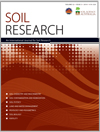SR13331A combined equation to estimate the soil pore-water electrical conductivity: calibration with the WET and 5TE sensors
Soil sensors of dielectric permittivity and electrical conductivity are needed in salt-threatened areas to know when to irrigate, in order to avoid the occurrence of both water and salinity stresses on plants. However, these sensors must be reliably calibrated, and this can only be carried out using an appropriate equation, and a reference method for soil salinity assessment at actual field water contents, such as those used in this work. Irrigators and developers of soil salinity sensors will benefit from this work.




